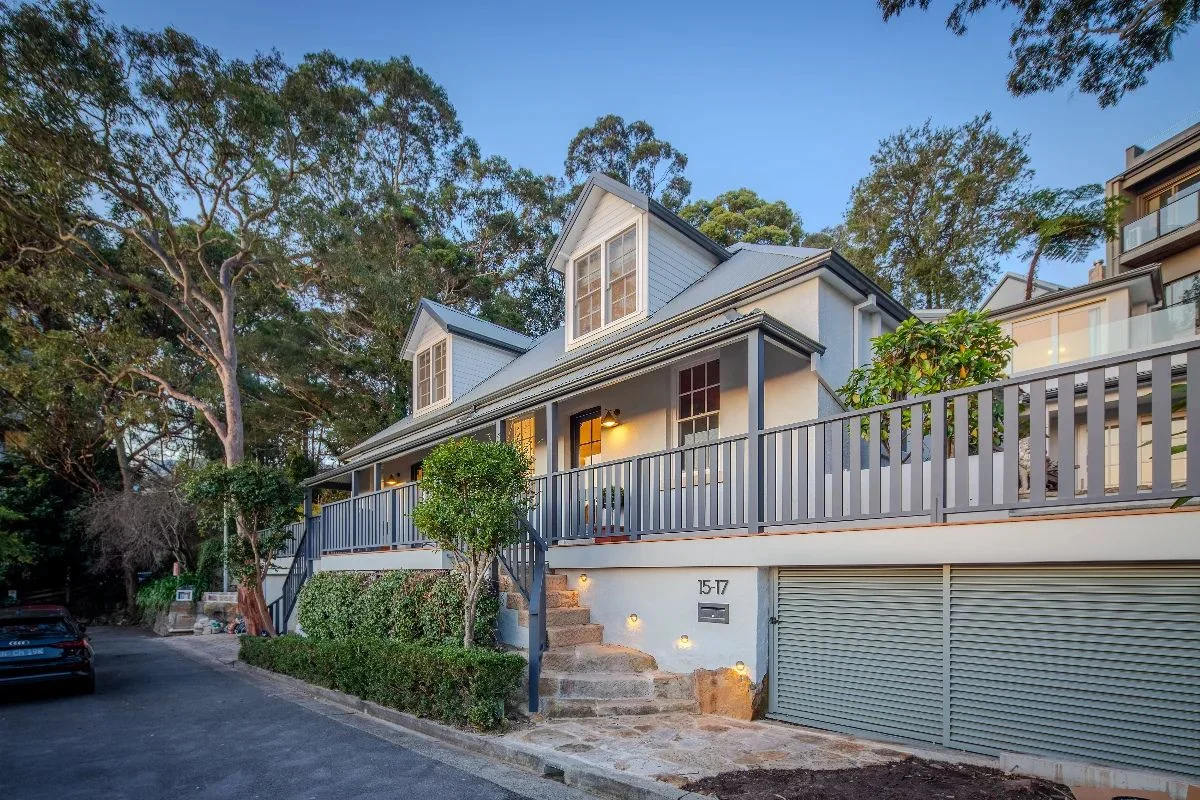Freshwater
Concept: Creating a light, airy, character-filled three-level Hampton-style beach home on a small corner site

Building or renovating a home on Sydney’s North Shore is more than just a construction project—it’s an opportunity to shape how you live for years to come. Whether you’re restoring a heritage cottage or designing a modern family home, every council in the region brings its own set of planning controls and priorities.
Understanding these regulations early can distinguish between a smooth approval process and months of delay. That’s where we come in. At Playoust Churcher Architects, we’ve spent decades working across North Sydney, Lane Cove, Hunters Hill, Willoughby and Ku-ring-gai and Northern Beaches councils—translating regulatory complexity into creative, buildable outcomes that reflect your goals, lifestyle, and the unique character of your site.
This guide outlines key planning considerations for the North Sydney council catchment. In future articles, we will discuss Lane Cove, Hunters Hill, and Willoughby councils and how we approach them to help our clients build with clarity, confidence, and purpose.
“Lorem ipsum dolor sit amet, consectetur adipiscing elit. Mauris justo elit, lobortis nec purus a, sagittis fermentum odio. Morbi interdum neque sed iaculis tristique. Sed et accumsan nulla.”
North Sydney blends the energy of an urban centre with the charm of established suburbs and sweeping harbour views. From federation homes in Waverton, Wollstonecraft, McMahons Point and Kirribilli to modern apartments in Neutral Bay and North Sydney proper, it’s a place where tradition meets transformation.
The council’s planning controls are among the most comprehensive in Sydney. They aim to preserve residential amenity, heritage character, view corridors, and sustainable design outcomes. This can seem daunting for homeowners, but with the right architectural approach, these rules become a launchpad for thoughtful, high-impact design.
North Sydney has many Heritage Conservation Areas (HCAs), and individual heritage-listed properties. These overlays require careful consideration of scale, form, and materiality. Rather than limiting creativity, they offer a chance to enhance the streetscape and honour the architectural story of your home.
Street-facing façades often must be preserved or sensitively restored. This can lead to compelling contrasts between old and new—restoring a traditional exterior while introducing a contemporary open-plan addition at the rear.
Council typically supports “reversible” changes—design elements that don’t permanently alter the original structure. This approach encourages adaptive reuse, such as turning a former fireplace nook into a lightwell or gallery niche.
If demolition is proposed, a robust Heritage Impact Statement is needed, and approval is far from guaranteed. We advise clients early on how to work with (rather than against) the property’s historical elements so your investment adds long-term value while satisfying council expectations.
In dense residential areas like Cremorne, Crows Nest, and Kirribilli, neighbours are close, and the Council is proactive in ensuring new development protects the light, outlook, and privacy of surrounding homes.
“Lorem ipsum dolor sit amet, consectetur adipiscing elit. Mauris justo elit, lobortis nec purus a, sagittis fermentum odio. Morbi interdum neque sed iaculis tristique. Sed et accumsan nulla.”

Minimum side and rear setbacks vary depending on zoning and lot size, but they are enforced to retain open space and minimise visual bulk. Clever design, such as offsetting upper levels or stepping back from the boundary, can maintain spatial flow while gaining council support.
Overshadowing is a common reason for DA refusal. The council requires neighbouring properties to retain at least 3 hours of direct sunlight to key living and private open spaces. Your project may need height modulation, light wells, or split levels to comply, but these often result in more dynamic architecture.
Privacy controls, such as limits on overlooking balconies or large upper-floor windows, guide us to develop creative screening strategies, such as timber battens, planter boxes, or clerestory glazing that admits light without intruding on neighbours’ privacy.
With its elevated blocks and harbour outlooks, North Sydney Council strongly emphasises retaining view corridors—public (e.g., toward the Harbour Bridge) and private.
Homes on sloping sites must be designed to minimise obstruction of key sightlines. The council may require visual impact assessments or view sharing analyses, particularly for additions that affect adjoining properties.
Roof pitch, eaves, and height transitions must consider the existing character of the street. For instance, a dramatic cantilever or flat roof form may be discouraged in a row of traditional gabled houses—unless it’s carefully resolved to echo existing rhythms and align with setbacks.
In foreshore or ridgeline areas, the Council may require additional landscape screening or a reduction in the building envelope to protect the visual amenity of the wider area. We often design tiered landscaping, transparent fencing, and low-profile built forms to comply with and highlight the site’s natural features.
North Sydney Council supports a growing emphasis on environmental responsibility and expects development applications to meet or exceed NSW sustainability standards. This is where smart design becomes a game-changer.
BASIX and water-sensitive urban design (WSUD) features are required, but we go further—integrating passive solar design, double glazing, thermal mass, and natural cross-ventilation into the home’s DNA.
Site runoff and stormwater management must be addressed early. Sloping blocks often require detention tanks, permeable paving, or integrated rain gardens to control flow and reduce the impact on neighbours and downstream systems.
The council actively supports green roofs and sustainable materials. A planted roof over a garage or rear extension can soften the built form and offer visual relief in dense environments while contributing to stormwater control and urban heat reduction.
Ultimately, North Sydney’s planning rules are about maintaining a sense of place—streets that feel cohesive, homes that sit comfortably in their setting, and buildings that enhance community life. Character controls apply to heritage zones and across many R2 and R3 areas. Council may assess form, bulk, colours, roof form, materials and even front fencing style.
This encourages a design ethos rooted in respect, not replication. A modern home can still belong in a historic street when it picks up the right visual cues—horizontal lines, scale, materials—and integrates them with clean, timeless detailing.
“Lorem ipsum dolor sit amet, consectetur adipiscing elit. Mauris justo elit, lobortis nec purus a, sagittis fermentum odio. Morbi interdum neque sed iaculis tristique. Sed et accumsan nulla.”

We are Sydney based architects specialising in residential heritage and contemporary renovations, outdoor extensions, and new building developments. An integral part of your journey with us is our comprehensive process approach, tailored to meet the demands of our clients and council regulatory frameworks. Our team is well-positioned to maximise livability and financial return and is committed to delivering value that minimises risk and ensures projects stay on schedule and within budget.
We invite you to view our case studies and to contact our team for a comprehensive consultation on your project.
North Sydney Council controls encompass rules on zoning (particularly R2), permissible building height, floor space ratio, setbacks, heritage overlays, and stormwater requirements. Understanding these requirements early is essential for successful project approval.
Yes—many neighbourhoods under North Sydney Council include heritage conservation overlays. Owners may need heritage impact statements and officer-liaised design to comply with façade materials, rooflines and preservation of character.
Yes. North Sydney Council supports small-scale design-led developments like dual occupancies or townhouses, particularly in R2 and RU zones, subject to development controls and site conditions.
Begin with a land feasibility review: we assess zoning, overlays, site constraints, and local planning controls to determine what development is permitted or feasible. This guides design and DA strategy from the outset.
We provide full DA support, including zoning analysis, consultant coordination (heritage, stormwater, waste), documentation and active liaison with council. Our aim is to streamline approvals while preserving design quality.
Absolutely. Council overlays, heritage constraints, or unique site conditions can extend DA timeframes. We help manage and mitigate delays by providing predicted timelines, cost clarity, and strategic direction as part of our consultancy.

North Sydney enforces some of Sydney’s most comprehensive planning controls—protecting heritage character, view corridors, residential amenity, and sustainable outcomes across varied precincts. However, these constraints can become design catalysts rather than barriers.

Homes within Heritage Conservation Areas (HCAs) must respect original scale, form, and materials. Instead of erasing history, Playoust Churcher advocates thoughtful interventions: preserving façades while introducing contemporary, reversible additions at the rear.

In densely street-oriented suburbs like Cremorne and Crows Nest, maintaining neighbours’ sun and sightlines is vital. Smart design techniques—like screened windows or split levels—help balance architectural ambition with neighbour considerations.

Understanding zoning, overlays, and planning expectations early on can avert costly delays. The firm’s decades of local experience help translate complex regulations into elegant, buildable solutions.
Managing Director & Nominated Architect
NSW Architect Registration No. 5924
With over 30 years of architectural experience, Brett Churcher leads Playoust Churcher Architects with a rare combination of design expertise and commercial insight. As a registered architect and Managing Director, Brett has played a pivotal role in delivering high-end single residential homes and boutique medium-density developments across Sydney’s North Shore and beyond.
Brett’s unique strength lies in his deep understanding of both architectural design and the Sydney property market. His valuation background enables him to align creative vision with practical feasibility, ensuring each project achieves both aesthetic excellence and financial viability.
At Playoust Churcher, Brett drives the studio’s growth, strategy, and leadership, while remaining closely connected to what matters most: the client. His ability to see the bigger picture from a client’s perspective and to guide projects seamlessly through the design process is at the heart of his role and reputation.

Reach out to Brett to explore how Playoust Churcher can bring it to life—with clarity, creativity and confidence.
Concept: Creating a light, airy, character-filled three-level Hampton-style beach home on a small corner site
Concept: Adapting a beautiful family heritage home in a quiet street on a large site to suit the family’s lifestyle
Concept: Designing a new family home that maximises the views and introduces a sense of open space
Concept: A complex yet successful renovation of this stunning heritage home in a conservation area
Concept: A 1970s build transformed into a bright, open design maximising stunning harbour views
Concept: A complete rebuild of half the property over two levels, whilst also incorporating the property next door
Concept: A majestic holiday home that pushes the design envelop, blending sustainable materials and natural light
Concept: A major ground floor renovation of a large estate with a new three-car garage and 14 metre pool
© Copyright Playoust Churcher 2025 All rights reserved. Website by Brilliant Digital.
We live and work on the lands of the Gadigal people of the Eora nation. We acknowledge their traditional custodianship of the land and pay respects to their Elders past, present and emerging.